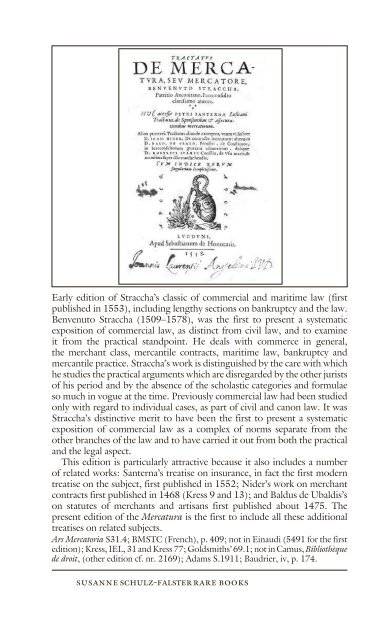Susanne Schulz-Falster Catalogue Eighteen - International League ...
Susanne Schulz-Falster Catalogue Eighteen - International League ...
Susanne Schulz-Falster Catalogue Eighteen - International League ...
Create successful ePaper yourself
Turn your PDF publications into a flip-book with our unique Google optimized e-Paper software.
Early edition of Straccha’s classic of commercial and maritime law (first<br />
published in 1553), including lengthy sections on bankruptcy and the law.<br />
Benvenuto Straccha (1509–1578), was the first to present a systematic<br />
exposition of commercial law, as distinct from civil law, and to examine<br />
it from the practical standpoint. He deals with commerce in general,<br />
the merchant class, mercantile contracts, maritime law, bankruptcy and<br />
mercantile practice. Straccha’s work is distinguished by the care with which<br />
he studies the practical arguments which are disregarded by the other jurists<br />
of his period and by the absence of the scholastic categories and formulae<br />
so much in vogue at the time. Previously commercial law had been studied<br />
only with regard to individual cases, as part of civil and canon law. It was<br />
Straccha’s distinctive merit to have been the first to present a systematic<br />
exposition of commercial law as a complex of norms separate from the<br />
other branches of the law and to have carried it out from both the practical<br />
and the legal aspect.<br />
This edition is particularly attractive because it also includes a number<br />
of related works: Santerna’s treatise on insurance, in fact the first modern<br />
treatise on the subject, first published in 1552; Nider’s work on merchant<br />
contracts first published in 1468 (Kress 9 and 13); and Baldus de Ubaldis’s<br />
on statutes of merchants and artisans first published about 1475. The<br />
present edition of the Mercatura is the first to include all these additional<br />
treatises on related subjects.<br />
Ars Mercatoria S31.4; BMSTC (French), p. 409; not in Einaudi (5491 for the first<br />
edition); Kress, IEL, 31 and Kress 77; Goldsmiths’ 69.1; not in Camus, Bibliothèque<br />
de droit, (other edition cf. nr. 2169); Adams S.1911; Baudrier, iv, p. 174.<br />
Skirts Neither Too Short Nor Too Long<br />
susanne schulz-falster rare books catalogue eighteen<br />
102. [SUMPTUARY LAWS.] Provisione Reformata sopra le<br />
Pompe, e Vestire cosi delle Donne come de gli Huomini, Apparati<br />
di Doti, & de Banchetti. Publicata alli vij & reiterrata alli viii di<br />
Genaro 1574. Bologna, Alessandro Benacci, 1574. £750<br />
4to, pp. [viii]; three heraldic woodcuts to title page, decorative initial;<br />
slight browning due to paper stock; folded, unbound as issued; a little<br />
dog-eared.<br />
First edition of rare sumptuary laws regulating dress and ornaments of the<br />
inhabitants of Bologna, in fact a revision of the laws promulgated in 1572.<br />
The dress code of women attracts particular attention, skirts are meant to<br />
be neither too long, nor too short, jewellery is to be worn in moderation.<br />
A single-strand pearl necklace is acceptable, unless it is too long – and<br />
variations apply depending on whether a woman is married or not. Special<br />
exceptions are made for weddings, but even then the social order needs to<br />
be upheld, and women have to be dressed according to rank and status.<br />
Contravention of the detailed rules leads to fines, which increase for repeat<br />
offenders.<br />
BL has 1560 edition, no others in OCLC.
















